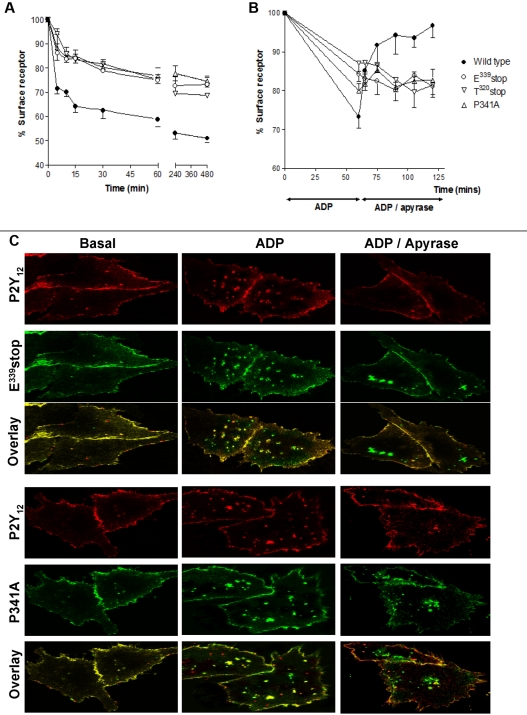Figure 3.
Agonist-induced internalization and traffic is blocked after removal or mutation of the PDZ ligand on the extreme C-terminus of the P2Y12 receptor. (A-B) CHO cells stably expressing either wild-type or mutant P2Y12 receptor were challenged with (A) ADP (10μM; 0-480 minutes) to induce receptor internalization or with (B) ADP (10μM; 60 minutes) to induce receptor internalization then apyrase (0.2 U/mL) to remove ADP and to promote subsequent receptor recycling. Surface receptor loss was subsequently assessed by ELISA as described in “Methods.” The data represent means ± SEMs of 5 independent experiments. (C) CHO cells stably expressing HA-tagged mutant receptor constructs were transiently transfected with FLAG-tagged wild-type P2Y12 receptor. Cells were preincubated with a monoclonal anti-HA or polyclonal anti-FLAG Ab at 4°C for 1 hour. Subsequently, cells were incubated at 37°C for 60 minutes in the absence or presence of agonist (ADP; 10μM). Cells were then incubated with apyrase for (0.2 U/mL) for 60 minutes. Receptor localization was determined by immunofluorescence in fixed cells and was visualized with a monoclonal fluorescein-conjugated or polyclonal rhodamine-conjugated secondary Ab. Groups of cells coexpressing wild-type receptor (red) with either E339stop (green) or P341A (green) are shown in the absence of agonist (Basal), after agonist treatment (ADP), or after agonist removal (ADP/apyrase). E339stop or P341A P2Y12 receptor (green) retained in the cells after agonist removal is clearly evident in the overlay. Data shown are representative of 3 independent experiments. Images were taken using a Leica SP5-AOBS confocal laser scanning microscope attached to a Leica DM I6000 inverted epifluorescence microscope with phase-contrast and a Plan-Apo 63×/1.40 NA oil immersion objective as stated in “Internalization and immunofluorescence microscopy.”

